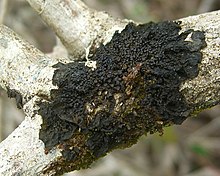Cyanolichen
This arrangement reflects the remarkable diversity within cyanolichens, which can feature filamentous or unicellular cyanobacteria, sometimes exhibiting multiple independent evolutionary origins across different fungal lineages.
This nitrogen fixation is critical in both forest canopies and arid-region soil crusts, and it helps cyanolichens act as pioneer species on newly exposed substrates.
Their sensitivity to substrate conditions—especially the bark pH of trees—helps explain their restricted distributions, and highlights the importance of mixed forest composition for sustaining cyanolichen populations.
Like other lichens, cyanolichens employ diverse reproductive strategies, including the production of sexual spores that must re-establish partnerships with compatible cyanobacteria, as well as the dispersal of symbiotic propagules containing both partners.
These intricacies have long posed methodological challenges for researchers, but advancements in molecular techniques are steadily uncovering new details of cyanolichen physiology and evolutionary history.
[3] Research into unicellular cyanobionts presents unique challenges due to their slow growth rates and the complexity of distinguishing between symbiotic and free-living forms under microscopic examination.
[4] Historically, genera such as Chroococcidiopsis were thought to be major cyanobionts in various cyanolichen families including Lichinaceae, but molecular studies have revealed a more complex picture, with many previously unrecognised unicellular cyanobacterial groups participating in lichen symbioses.
This broad taxonomic distribution suggests that the ability to form symbioses with cyanobacteria has evolved multiple times independently across distantly related fungal groups.
This pH requirement helps explain why some tree species support more diverse cyanolichen communities than others, as conifer bark tends to be naturally acidic.
Successful cyanolichen colonisation often depends on various mechanisms that can increase bark pH, such as nutrient enrichment from nearby deciduous trees or the presence of other buffering substances.
[7] For sexually reproducing cyanolichens, the process begins when fungal spores not only germinate but also must locate a compatible photosynthetic partner (photobiont) to form a new lichen.
[8] Moreover, the cyanobacterial photobionts of some cyanolichen species show very limited capacity for independent growth—they often grow slowly and are unable to produce motile hormogonia (reproductive filaments).
The overall success of sexual reproduction largely depends on the availability of suitable photobionts; some fungal species are highly selective, while others can associate with a broader range of partners.
Photosymbiodemes thus represent a flexible reproductive strategy, potentially allowing the fungal partner to adapt to varying environmental conditions by altering its photobiont associations.
While early research relied primarily on microscopic observation, modern studies employ a variety of molecular and genomic techniques to understand these complex relationships.
Unicellular cyanobionts are particularly challenging to study due to their slow growth rates and the presence of multiple free-living cyanobacterial species that may grow on or near lichen thalli.
Their cyanobacterial partners, often from the order Nostocales, are typically housed in cephalodia, specialised structures that regulate oxygen levels and help maintain photobiont function during hydration cycles.
These cyanobacterial symbionts have been observed to form densely packed colonies within the lichen thallus, creating hypoxic microenvironments that may facilitate nitrogen fixation while protecting them from oxidative stress.
Research has revealed that lichen-associated Nostoc can employ both molybdenum- and vanadium-dependent nitrogen fixation pathways, providing metabolic flexibility in environments where different trace elements may be scarce.
[24] An important ecological phenomenon known as the "dripzone effect" occurs when nutrient-rich leachates from deciduous trees, particularly species of poplar (Populus), significantly enhance cyanolichen colonisation on nearby conifers.
This relationship demonstrates how deciduous trees can indirectly facilitate nitrogen fixation in forest ecosystems by promoting cyanolichen colonisation on conifers that might otherwise be too acidic to support these sensitive organisms.
[12] The evolutionary history of cyanolichens represents multiple independent origins of symbiotic relationships between fungi and cyanobacteria, with evidence spanning hundreds of millions of years.
While lichen fossils are generally rare, amber specimens from the Tertiary period have preserved examples of several extant genera, providing insights into their evolutionary persistence.
This fossil, named Winfrenatia reticulata, consisted of a thallus composed of fungal filaments with depressions containing coccoid cyanobacteria similar to modern Gloeocapsa or Chroococcidiopsis.
[27] Early cyanolichen evolution may have been driven by the need for the photobiont to retain liquid water, as evidenced by thick mucilaginous sheaths around cyanobacterial cells in the earliest known fossil lichens.
[31] This distinction highlights how green algal photobionts tend to co-evolve with their fungal hosts, whereas cyanobacterial symbionts are more frequently exchanged across different lichen lineages.
For instance, air pollutants like sulphur dioxide and nitrogen compounds have led to local extinctions in industrial regions, while habitat loss and climate change further threaten these organisms.
In arid regions, the conservation of soil crust communities has become increasingly important as these ecosystems face mounting pressures from climate change and land use intensification.
[35] Key conservation measures include maintaining pressure on governments to regulate air pollution, particularly from coal-fired power plants that contribute to acid rain, and preserving old-growth forest stands that harbour rare species.
The presence of deciduous trees, particularly Populus species, in young forest stands can be critical for initial cyanolichen establishment through their facilitation of suitable bark chemistry on neighbouring conifers.












